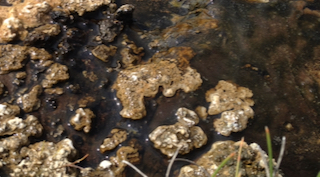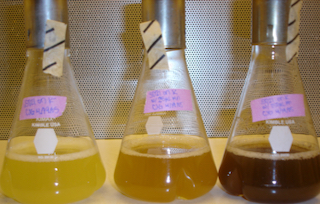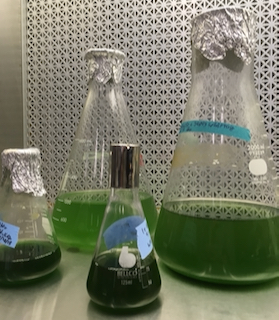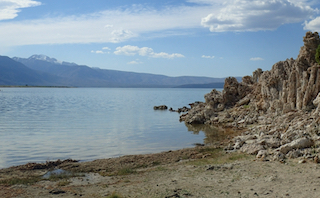Hope A. Johnson
Professor
Biography
Dr. Johnson teaches General Microbiology (Biol 302), Genetics and Molecular Biology (Biol 251), Advances in Microbiology (Biol 430), and Advances in Microbiology Lab (Biol 431). Dr. Johnson has an undergraduate degree in Civil Engineering from Cornell University. As a Master’s student at Stanford University, she discovered and fell in love with microbiology. After completing her PhD at Stanford, she was a postdoctoral researcher at Scripps Institution of Oceanography and The Scripps Research Institute before joining CSUF.
Degrees
PhD, Stanford University
MS, Stanford University
BS, Cornell University
Research Areas
 Black Mn oxides on the surface of a hot spring microbial mat.
Black Mn oxides on the surface of a hot spring microbial mat.
Our lab works on how microbes impact and respond to their environment - environmental microbiology. We are interested in the molecular mechanisms of microbes in biogeochemical cycling and the processes that can be utilized to clean our soil and water.
The main focus of the lab is on bacterial manganese oxidation. Manganese is a transition metal with multiple oxidation states in the natural environment - Mn2+, Mn3+, and Mn4+. The oxidation state affects the fate of the element - is it soluble or insoluble and its reactivity. Insoluble Mn(IV) oxides are some of the most reactive compounds in nature! Therefore, Mn cycling can affect the cycling of carbon, sulfur, nitrogen, and other metals.
We are interested in how and why bacteria can oxidize Mn(II) to Mn(III) and Mn(IV). This involves identifying and studying genes and enzymes. It also includes understanding how this process is integrated into cellular physiology.


Much of what we do is at the intersection of biology, chemisty, and geology.
Other interests include:
- Macro structures formed by cyanobacteria that can bepreserved in the fossil record

- The evolution of oxygenic photosynthesis

- Protein function prediction
- Anaerobic hydrocarbon degradation
- Bioremediation
- Microbial ecology of hot springs and lakes

If you are interested in joining our lab, contact Dr. Johnson - hajohnson@fullerton.edu
Courses Regularly Taught
Genetics and Molecular Biology (Biol 251), General Microbiology (Biol 302), Advances in Microbiology (Biol 430), Advanced Microbiology Lab (Biol 431)
Publications
Medina, M., Rizo, A., Dinh, D., Chau, B., Omidvar, M., Juarez, A., Ngo, J., and Johnson, H.A. MopA, the Mn oxidizing protein from Erythrobactersp. SD-21 requires heme and NAD+for Mn(II) oxidation. Frontiers in Microbiology, 9:2671. 2018.
Wilmeth, D.T., Johnson, H.A., Stamps, B.W., Berelson, W.M., Stevenson, B.S., Nunn, H.S., Grim, S.L., Dillon, M.L., Pradis, O., Corsetti, F.A., Spear, J.R. Environmental and biological influences on carbonate precipitation within hot spring microbial mats in Little Hot Creek, CA. Frontiers in Microbiology, 9:1464. 2018.
Kraus, E.A., Beeler, S.R., Mors, R.A., Floyd, J.G., Stamps, B.W., Nunn, H.S., Stevenson, B.S., Johnson, H.A., Shapiro, R.S., Loyd, S.J., Spear, J.R., and Corsetti, F.A. Microscale biosignatures and abiotic mineral authigenesis in Little Hot Creek, California. Frontiers in Microbiology, 9:997. 2018.
Bradley, J.A., Daille, L.K., Trivedi, C.B., Bojanowski, C.L., Stamps, B.W., Stevenson, B.S., Nunn, H.S., Johnson, H.A., Loyd, S.J., Berelson, W.M., Corsetti, F.A., and Spear, J.R. Carbonate-rich dendrolitic cones: insights into a modern analog for incipient microbialite formation, Little Hot Creek, Long Valley Caldera, California, npj Biofilms and Microbiomes3(32). eCollection 2017.
Deller, M.C., Johnson, H.A., Miller, M.D., Spraggon, G., Elsliger, M.A., Wilson, I.A., and Lesley, S.A. Crystal structure of a two-subunit TrkA octameric gating ring assembly. PLoS One 10(3): e0122512. 2015.
Nakama, K., Medina, M., Lien, A., Ruggieri, J., Collins, K., and Johnson, H.A. Heterologous expression and characterization of the manganese oxidizing protein from Erythrobacter sp. strain SD21. Applied and Environmental Microbiology 80(21): 6837-42. 2014.
Banh, A., Chavez, V., Doi, J., Nguyen, A., Hernandez, S., Ha, V., Jimenez, P., Espinoza, F., and Johnson, H.A. Manganese (Mn) oxidation increases intracellular Mn in Pseudomonas putida GB-1. PLoS One 8(10): e77835. 2013.
Reyes, K., Gonzalez, N.I., Stewart, J., Ospino, F., Nguyen, D., Cho, D.T., Ghahremani, N., Spear, J.R., and Johnson, H.A. Surface orientation affects the direction of cone growth by Leptolyngby sp. strain C1, a likely architect of coniform structures in Octopus Spring (Yellowstone National Park). Applied and Environmental Microbiology 79(4): 1302-8. 2013. Cover image.
Anderson, C.R., Johnson, H.A., Caputo, N., Davis, R.E., Torpey, J.W., and Tebo, B.M. Mn(II) oxidation is catalyzed by heme peroxidases in " Aurantimonas manganoxydans " strain SI85-9A1 and Erythrobacter sp. strain SD-21. Applied and Environmental Microbiology 75(12):4130-8. 2009.
Johnson, H.A., Hampton, E. and Lesley, S. A . The Thermotoga maritima Trk potassium transporter – from frameshift to function. Journal of Bacteriology 191: 2276-84. 2009.
Dick, G.J., Podell, S., Johnson, H.A., Rivera-Espinoza, Y., Bernier-Latmani, R., McCarthy, J.K., Torpey, J.W., Clement, B.G., Gaasterland, T., and Tebo, B. M. Genomic insights into Mn(II) oxidation by the marine α -proteobacterium Aurantimonas sp. strain SI85-9A1. Applied and Environmental Microbiology 74: 2646-58. 2008.
Johnson, H.A. and Tebo, B.M. In vitro studies indicate a quinone is involved in bacterial Mn(II) oxidation. Archives of Microbiology 189: 59-69. 2008.
Websites
Check out the lab Facebook Page!
https://www.facebook.com/pages/category/Education/Johnson-Microbiology-Lab-at-CSUF-186514168075654/

